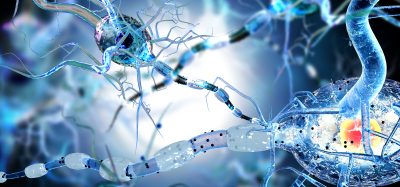AI designs peptides for ‘undruggable’ diseases
Posted: 4 February 2025 | Drug Target Review | No comments yet
A new AI-powered approach is tackling the challenge of ‘undruggable’ diseases by designing peptides that can bind to and destroy previously untreatable proteins.


Biomedical engineers at Duke University have developed a novel AI-based platform that designs short proteins, known as peptides, capable of targeting and destroying previously ‘undruggable’ disease-causing proteins. Inspired by OpenAI’s image generation model, their new algorithm rapidly identifies promising peptides for experimental testing, offering a potential breakthrough in treating a wide range of diseases.
The research, published in Science Advances, addresses the challenge disordered proteins pose. While conventional drug therapies effectively target well-defined protein structures, over 80 percent of disease-causing proteins are disordered and tangled, making it incredibly difficult for standard treatments to bind and function.
Peptides, being smaller versions of proteins, offer an alternative approach. They can bind to various amino acid sequences throughout a protein, even without the need for surface ‘pockets’. However, designing peptides to target unstable or highly tangled protein structures has remained a significant hurdle.
Biomarkers are redefining how precision therapies are discovered, validated and delivered.
This exclusive expert-led report reveals how leading teams are using biomarker science to drive faster insights, cleaner data and more targeted treatments – from discovery to diagnostics.
Inside the report:
- How leading organisations are reshaping strategy with biomarker-led approaches
- Better tools for real-time decision-making – turning complex data into faster insights
- Global standardisation and assay sensitivity – what it takes to scale across networks
Discover how biomarker science is addressing the biggest hurdles in drug discovery, translational research and precision medicine – access your free copy today
Inspired by generative AI
Rather than attempting to map the 3D structures of these challenging proteins, the Duke team, led by Assistant Professor Pranam Chatterjee, drew inspiration from generative large language models (LLMs). Their solution, PepPrCLIP, combines two key components. PepPr, a generative algorithm trained on a vast library of natural protein sequences, designs new ‘guide’ proteins with specific characteristics. CLIP, adapted from OpenAI’s image-caption matching algorithm, then screens these peptides, identifying those that best match their target proteins based solely on the target’s sequence.
“OpenAI’s CLIP algorithm connects language with an image. If you have text that says ‘dog,’ you should get an image of a dog,” explained Chatterjee. “Instead of language and image, we trained it to match peptides and proteins. PepPr makes the peptides, and our adapted CLIP algorithm will screen those peptides and tell us which ones will make a good match.”
Superior performance and experimental validation
In tests against RFDiffusion, an existing peptide generation platform that relies on 3D protein structure, PepPrCLIP proved faster and generated peptides that were consistently a better match for their target proteins. The platform’s effectiveness was further validated through collaborations with researchers at Duke University Medical School, Cornell University, and Sanford Burnham Prebys Medical Discovery Institute.
The team successfully demonstrated PepPrCLIP’s ability to design peptides that could bind to and inhibit UltraID, a stable enzyme protein. More impressively, they designed peptides targeting beta-catenin, a disordered protein implicated in various cancers. Four out of six PepPrCLIP-generated peptides effectively bound to and degraded beta-catenin, potentially slowing down cancer cell signalling.
Tackling the ‘spaghetti bowl’ protein
The team’s most challenging test involved designing peptides to bind to a highly disordered protein associated with synovial sarcoma, a rare and aggressive cancer affecting mostly children and young adults. Chatterjee described the protein as “like a bowl of spaghetti. It’s the most disordered protein in the world.”
Despite the protein’s complex structure, PepPrCLIP-designed peptides successfully bound to and degraded it within synovial sarcoma cells. This achievement offers a potential pathway to developing therapies for this previously ‘undruggable’ cancer.
Future directions
Chatterjee and his team are committed to refining their platform and plan to collaborate with medical and industry partners to develop peptides for new therapies. They aim to target diseases caused by unstable proteins, including Alexander’s Disease and various cancers.
“These complex, disordered proteins have made a lot of cancers and diseases practically undruggable because we couldn’t design molecules that bind to them,” said Chatterjee. “But PepPrCLIP showed that it could work on even the most complicated protein, and that opens up a lot of exciting clinical possibilities.”
Related topics
Artificial Intelligence, Cancer research, Drug Discovery, Drug Discovery Processes, Informatics, Peptide Therapeutics
Related conditions
Alexander’s disease, Cancer, Synovial Sarcoma
Related organisations
Cornell University, Duke University, Duke University Medical School, Sanford Burnham Prebys Medical Discovery Institute
Related people
Pranam Chatterjee








